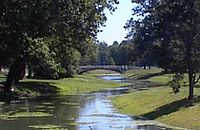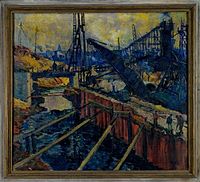- River des Peres
-
The River des Peres is a 9.3-mile-long (15.0 km)[1] metropolitan river in St. Louis, Missouri. It is the backbone of sanitary and stormwater systems in the city of St. Louis and portions of St. Louis County. Its largest tributaries are Deer Creek and Gravois Creek.
Contents
History
The name, meaning "River of the Fathers", is of French origin, and was given by locals because a mission of Jesuit Catholic priests resided near the confluence of the river with the Mississippi. The priests were established in 1700 and soon moved south in 1703 to Kaskaskia, probably as a result of conflict with American Indians, roughly 60 years prior to the founding of St. Louis. There is also a city of the same name, located in west St. Louis County.
In preparation for the 1904 World's Fair, the portion that flows through Forest Park was disguised by temporary wooden channels. Shortly thereafter, that portion was placed entirely underground. More recently, an artificial water flow was created in its stead, using the city's water supply. This is often mistakenly considered a re-creation of the original River des Peres. However, the water flow here is deliberately produced, not derived from rainfall, or runoff, etc., and thus cannot be considered a re-creation of the river. The resemblance of the water feature to a picturesque river scene was an attempt to maintain continuity with the appearance of the rest of Forest Park's landscape, which for the most part, excepting significantly recent additions to the Art Museum (by Peter Walker), upholds the original, early twentieth century pastoral design intentions of George Kessler. The artistic decision to create an artificial water body that resembles a natural flow, rather than capitalizing on the opportunity to truly re-create the park with the tools of a contemporary aesthetic, has been highly scrutinized, along with the questionable use of such a large supply of fresh water and technological resources.[2]
The River des Peres has functioned as a combined sanitary sewer and storm drain for over a hundred years. In the early 1930s, following high demand for preventive safety measures brought on by a series of fatal floods, the river was channelized, with its upper sections redirected underground in large sewage pipes. Design and construction was led by the United States Army Corps of Engineers, Horner & Shifrin, and the Works Progress Administration. The lower banks of the river, most notably along Willmore Park and the River des Peres Greenway, were lined with quarried limestone, producing a distinct landmark for decades to come. "Safety First / W.P.A." is written in mosaics along the eastern banks.
In 1988, the American Society of Civil Engineers added the River des Peres Sewage & Drainage Works to its list of Historic Civil Engineering Landmarks for the calculations involved, the large-scale trench dewatering methods and the soil stabilization procedures.[3]
The area near where the River des Peres flows into the Mississippi River was the site of some of the worst flooding of the Great Flood of 1993.
Current condition
The River des Peres is channelized from its southernmost point - its confluence with the Mississippi - up to its "end pipes," just south of Forest Park. The end pipes re-emerge north of Forest Park. It is generally perceived as a degraded stream or river (depending on the portion in question). The River des Peres currently functions as a major element in the combined sewer and storm water management system of its watershed, which includes large portions of St. Louis City and County. It is currently operated by the St. Louis Metropolitan Sewer District (MSD) with that function as its highest priority. The agencies that maintain most authority over its domain are MSD and the United States Army Corps of Engineers (USACE). The functions of sanitary water management are of highest concern to MSD, and general flood and safety concerns are those of the USACE.
The River des Peres Greenway Project is planned to create an 11-mile (18 km) linear park along the river's route from Forest Park to the Mississippi River. It is to be part of a larger system of works as part of the River Ring project by The Great Rivers Greenway District.
See also
- List of Missouri rivers
References
- ^ U.S. Geological Survey. National Hydrography Dataset high-resolution flowline data. The National Map, accessed May 13, 2011
- ^ http://www.asla.org/land/LAM011204.html
- ^ "River des Peres Sewerage and Drainage Works". American Society of Civil Engineers. http://live.asce.org/hh/index.mxml?lid=138&versionChecked=true. Retrieved 2007-10-24.
External links
- A Sewer Runs Through It- an article that appeared in the Riverfront Times on December 6, 2000.
- River des Peres Greenway Project
- The Harnessed Channel: How the River Des Peres Became an Open Sewer
- The River des Peres Watershed Coalition
- "Land Matters" February 2004Landscape Architecture Magazine. Editorial critique of the pseudo-River des Peres water feature in Forest Park.
- River des Peres Living Room at B.E.L.T.
- "River des Peres Plan" 1916. St. Louis City Planning Commission
Categories:- Rivers of Missouri
- Tributaries of the Mississippi River
- Geography of St. Louis, Missouri
Wikimedia Foundation. 2010.



